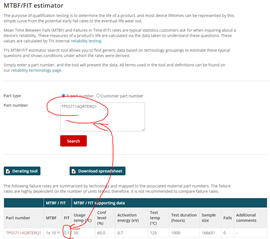Regarding TI's "TPS57114QRTERQ1"
On TI website MTBF/FIT estimator we get FIT rate of 0.1
But on the Technical documentation section of this PN we get FIT rate of 11!
Can some
 one please explain this significant difference?
one please explain this significant difference?
This thread has been locked.
If you have a related question, please click the "Ask a related question" button in the top right corner. The newly created question will be automatically linked to this question.
Regarding TI's "TPS57114QRTERQ1"
On TI website MTBF/FIT estimator we get FIT rate of 0.1
But on the Technical documentation section of this PN we get FIT rate of 11!
Can some
 one please explain this significant difference?
one please explain this significant difference?
Hello user,
I will take care of your question.
Let me come back to you by mid of this week.
Thanks a lot!
Regards,
Dorian
Hello user,
First of all both FIT rates are correct. However, the two FIT rates are not the same and should not be confused as they are calculated on two fundamentally different methods.
This data (0.1 FIT for TPS57114QRTERQ1) that you find on TI’s reliability estimator is the classical MTBF calculation based on the real TI reliability testing of real samples (HTOL, ELFR, etc.) normalized to a duration of 1000 h at a test temperature of 125°C (for details see the explanation on the link). Currently the device data, based on a sample size of 166651 tested for 1000 hrs and zero fails, gives a FIT rate of 0.1 . The FIT rate is very low due to the high sample size and high device hours for this mature technology.
Note that the TPS57114QRTERQ1 is EOL and should not be used anymore in new application. The replacement part is TPS57114CQRTERQ1 the same device (drop-in replacement with same data sheet parameters) but with improved quality. The only difference between the two part numbers is the added polyimide layer providing a much improved robustness and quality performance.
Let me know if you have any further questions or comments.
Thanks a lot!
Regards,
Dorian
Hello user,
Do you have any further questions here ?
Let me know.
Thanks a lot!
Regards,
Dorian
Hello user,
Due to inactivity, I will close this thread.
If you have any further questions or want to re-open the thread, please reply blow.
Thanks a lot!
Regards,
Dorian